
Flexor Tendon Injuries
A deep cut on the palm side of your fingers, hand, wrist, or forearm can damage your flexor tendons, which are the tissues that help control movement in your hand. A flexor tendon injury can make it impossible to bend your fingers or thumb.
AnatomyTendons are tissues that connect muscles to bone. When muscles contract, tendons pull on bones. This causes parts of the body (such as a finger) to move.
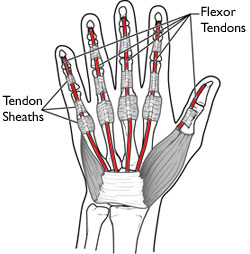 The flexor tendons allow you to bend your fingers.
The flexor tendons allow you to bend your fingers.
The muscles that move the fingers and thumb are located in the forearm. Long tendons extend from these muscles through the wrist and attach to the small bones of the fingers and thumb.
The tendons on the top of the hand straighten the fingers. These are known as extensor tendons.The tendons on the palm side bend the fingers. These are known as the flexor tendons.
When you bend or straighten your finger, the flexor tendons slide through snug tunnels, called tendon sheaths, that keep the tendons in place next to the bones.
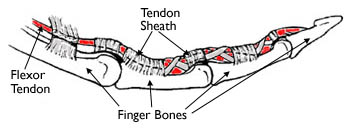 Tendon sheaths keep the tendons in place.
Description
Tendon sheaths keep the tendons in place.
Description
A torn or cut tendon in the forearm, at the wrist, in the palm, or along the finger will make it impossible to bend one or more joints in a finger.
Because flexor tendons are very close to the surface of the skin, a deep cut will most likely hit a flexor tendon. In these cases, the tendon is often cut into two pieces.
Like a rubber band, tendons are under tension as they connect the muscle to the bone. If a tendon is torn or cut, the ends of the tendon will pull far apart, making it impossible for the tendon to heal on its own.
Because the nerves to the fingers are also very close to the tendons, a cut may damage them, as well. This will result in numbness on one or both sides of the finger. If blood vessels are also cut, the finger may have no blood supply. This requires immediate surgery.
Occasionally, flexor tendons may be partially cut or torn. With a partial tendon tear, it may still be possible to bend your finger, but not completely. These types of tears can be difficult to diagnose.
CausesIn addition to cuts on the arm, hand, or fingers, certain sports activities can cause flexor tendon injuries. These injuries often occur in football, wrestling, and rugby. "Jersey finger" is one of the most common of these sports injuries. It can happen when one player grabs another's jersey and a finger (usually the ring finger) gets caught and pulled. The tendon is pulled off the bone. In sports that require a lot of arm and hand strength, such as rock climbing, tendons and/or their sheaths can also be stretched or torn.
Certain health conditions (rheumatoid arthritis, for example) weaken the flexor tendons and make them more likely to tear. This can happen without warning or injury — a person may simply notice that his or her finger no longer bends, but cannot recall how it could have happened.
SymptomsThe most common signs of a flexor tendon injury include:
- An open injury, such as a cut, on the palm side of your hand, often where the skin folds as the finger bends
- An inability to bend one or more joints of your finger
- Pain when your finger is bent
- Tenderness along your finger on the palm side of your hand
- Numbness in your fingertip
It is important to see a doctor whenever the fingers are injured. This is especially true if your finger is jammed and you cannot bend or straighten your fingertip.
First Aid
When you have a serious cut to your hand or fingers, apply ice immediately. Tightly wrap your hand with a clean cloth or bandage to slow down the bleeding. Elevate your hand by keeping it lifted above your heart. See a doctor as soon as possible.
Your doctor may first clean and treat any wounds that are not deep. You may need a tetanus shot or antibiotics to prevent infection.
Physical Examination
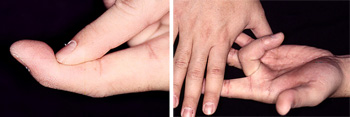 These standard examination tests help your doctor determine if a tendon or nerve has been injured.
These standard examination tests help your doctor determine if a tendon or nerve has been injured.
During the examination, your doctor will ask you to bend and straighten your fingers. To test your finger strength, your doctor may have you try to bend your injured finger while he or she holds the other fingers down flat. To determine whether any nerves or blood vessels have been injured, your doctor may test your hand for sensation and blood flow to the fingers.
Additional Tests
Your doctor may also order an x-ray to see if there is any damage to the bone.
Treatment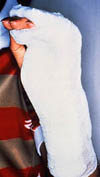 Your hand may be placed in a splint for protection prior to surgery.
Your hand may be placed in a splint for protection prior to surgery.
After examining your hand, your doctor may place your hand in a splint for protection.
Tendons cannot heal unless the ends are touching, which does not occur with a complete tear. In most cases, a cut or torn tendon must be repaired by a doctor. This requires surgery.
Surgery is usually performed within 7 to 10 days after an injury. In general, the sooner surgery is performed, the better recovery will be.
If your injury is restricting blood flow to your hand or finger, your doctor will schedule an immediate surgery.
Surgical Procedure
Because tendons tear in different ways — such as straight across, at an angle, or pulled right off of the bone — there are many different methods for your surgeon to repair them. All the methods for repair, however, involve special sutures, which are stitches.
Surgery is usually performed on an outpatient basis (you may go home the day of surgery). Your doctor will apply a dressing and splint after the surgery. Many doctors use a plastic type of splint to protect the repair. Your fingers and wrist will be placed in a bent position to keep tension off the repair.
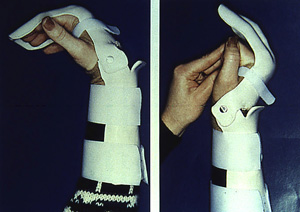 After surgery, a splint is applied to limit movement and help the tendon heal.
After surgery, a splint is applied to limit movement and help the tendon heal.
Recovery from Surgery
It can take up to 2 months before the repair heals and your hand is strong enough to use without protection. It may take another month or so before your hand can be used with any force.
Soon after surgery, you will begin physical therapy. Specific exercises will help you gradually regain motion and function. Stiffness after surgery is common, but it usually responds to therapy.
Splint wear and proper exercise, exactly as prescribed by your therapist, are as important to recovery as the surgery itself.
Treatment for Partial Tears
Recent evidence suggests that partially torn tendons do not require surgery for good results. The same splinting and exercise programs that are used for surgery patients can be very effective for patients with partial tears, but with no surgery necessary.
This nonsurgical treatment option is appropriate only after the doctor has explored the wound to accurately assess the extent of the injury.
Long-Term OutcomesOver the last several decades, advanced research and experience in the treatment of flexor tendon injuries have resulted in improved patient outcomes. Flexor tendon injuries, however, can be very challenging to treat.
Despite extensive therapy, some patients have long-term stiffness after flexor tendon injuries. Sometimes, a second surgery is required to free up scar tissue and to help the patient regain motion.
Overall, flexor tendon surgery results in good return of function and high patient satisfaction.
Source: http://orthoinfo.aaos.org/topic.cfm?topic=A00015
